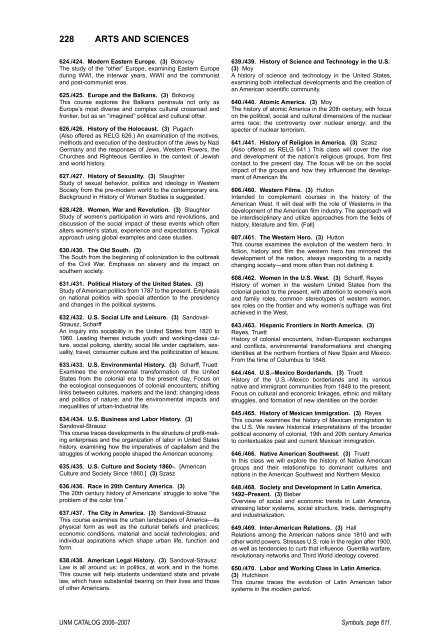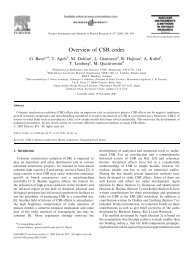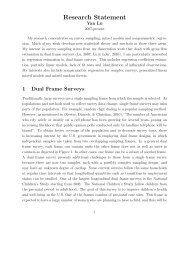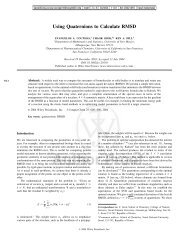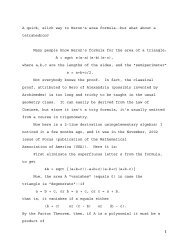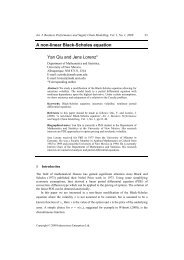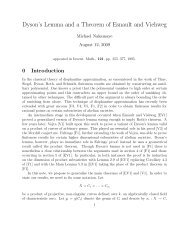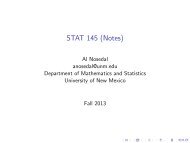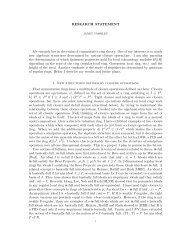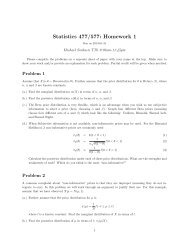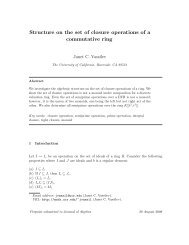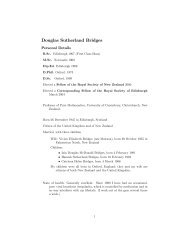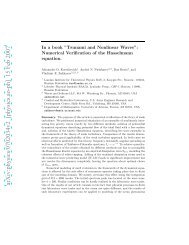OEO Office of Equal Opportunity - Department of Mathematics and ...
OEO Office of Equal Opportunity - Department of Mathematics and ...
OEO Office of Equal Opportunity - Department of Mathematics and ...
You also want an ePaper? Increase the reach of your titles
YUMPU automatically turns print PDFs into web optimized ePapers that Google loves.
228 ARTS AND SCIENCES<br />
624./424. Modern Eastern Europe. (3) Bokovoy<br />
The study <strong>of</strong> the “other” Europe, examining Eastern Europe<br />
during WWI, the interwar years, WWII <strong>and</strong> the communist<br />
<strong>and</strong> post-communist eras.<br />
625./425. Europe <strong>and</strong> the Balkans. (3) Bokovoy<br />
This course explores the Balkans peninsula not only as<br />
Europe’s most diverse <strong>and</strong> complex cultural crossroad <strong>and</strong><br />
frontier, but as an “imagined” political <strong>and</strong> cultural other.<br />
626./426. History <strong>of</strong> the Holocaust. (3) Pugach<br />
(Also <strong>of</strong>fered as RELG 626.) An examination <strong>of</strong> the motives,<br />
methods <strong>and</strong> execution <strong>of</strong> the destruction <strong>of</strong> the Jews by Nazi<br />
Germany <strong>and</strong> the responses <strong>of</strong> Jews, Western Powers, the<br />
Churches <strong>and</strong> Righteous Gentiles in the context <strong>of</strong> Jewish<br />
<strong>and</strong> world history.<br />
627./427. History <strong>of</strong> Sexuality. (3) Slaughter<br />
Study <strong>of</strong> sexual behavior, politics <strong>and</strong> ideology in Western<br />
Society from the pre-modern world to the contemporary era.<br />
Background in History <strong>of</strong> Women Studies is suggested.<br />
628./428. Women, War <strong>and</strong> Revolution. (3) Slaughter<br />
Study <strong>of</strong> women’s participation in wars <strong>and</strong> revolutions, <strong>and</strong><br />
discussion <strong>of</strong> the social impact <strong>of</strong> these events which <strong>of</strong>ten<br />
alters women’s status, experience <strong>and</strong> expectations. Typical<br />
approach using global examples <strong>and</strong> case studies.<br />
630./430. The Old South. (3)<br />
The South from the beginning <strong>of</strong> colonization to the outbreak<br />
<strong>of</strong> the Civil War. Emphasis on slavery <strong>and</strong> its impact on<br />
southern society.<br />
631./431. Political History <strong>of</strong> the United States. (3)<br />
Study <strong>of</strong> American politics from 1787 to the present. Emphasis<br />
on national politics with special attention to the presidency<br />
<strong>and</strong> changes in the political systems.<br />
632./432. U.S. Social Life <strong>and</strong> Leisure. (3) S<strong>and</strong>oval-<br />
Strausz, Scharff<br />
An inquiry into sociability in the United States from 1820 to<br />
1960. Leading themes include youth <strong>and</strong> working-class culture,<br />
social policing, identity, social life under capitalism, sexuality,<br />
travel, consumer culture <strong>and</strong> the politicization <strong>of</strong> leisure.<br />
633./433. U.S. Environmental History. (3) Scharff, Truett<br />
Examines the environmental transformation <strong>of</strong> the United<br />
States from the colonial era to the present day. Focus on<br />
the ecological consequences <strong>of</strong> colonial encounters; shifting<br />
links between cultures, markets <strong>and</strong> the l<strong>and</strong>; changing ideas<br />
<strong>and</strong> politics <strong>of</strong> nature; <strong>and</strong> the environmental impacts <strong>and</strong><br />
inequalities <strong>of</strong> urban-industrial life.<br />
634./434. U.S. Business <strong>and</strong> Labor History. (3)<br />
S<strong>and</strong>oval-Strausz<br />
This course traces developments in the structure <strong>of</strong> pr<strong>of</strong>it-making<br />
enterprises <strong>and</strong> the organization <strong>of</strong> labor in United States<br />
history, examining how the imperatives <strong>of</strong> capitalism <strong>and</strong> the<br />
struggles <strong>of</strong> working people shaped the American economy.<br />
635./435. U.S. Culture <strong>and</strong> Society 1860-. [American<br />
Culture <strong>and</strong> Society Since 1860.] (3) Szasz<br />
636./436. Race in 20th Century America. (3)<br />
The 20th century history <strong>of</strong> Americans’ struggle to solve “the<br />
problem <strong>of</strong> the color line.”<br />
637./437. The City in America. (3) S<strong>and</strong>oval-Strausz<br />
This course examines the urban l<strong>and</strong>scapes <strong>of</strong> America—its<br />
physical form as well as the cultural beliefs <strong>and</strong> practices;<br />
economic conditions, material <strong>and</strong> social technologies; <strong>and</strong><br />
individual aspirations which shape urban life, function <strong>and</strong><br />
form.<br />
638./438. American Legal History. (3) S<strong>and</strong>oval-Strausz<br />
Law is all around us: in politics, at work <strong>and</strong> in the home.<br />
This course will help students underst<strong>and</strong> state <strong>and</strong> private<br />
law, which have substantial bearing on their lives <strong>and</strong> those<br />
<strong>of</strong> other Americans.<br />
639./439. History <strong>of</strong> Science <strong>and</strong> Technology in the U.S.<br />
(3) Moy<br />
A history <strong>of</strong> science <strong>and</strong> technology in the United States,<br />
examining both intellectual developments <strong>and</strong> the creation <strong>of</strong><br />
an American scientific community.<br />
640./440. Atomic America. (3) Moy<br />
The history <strong>of</strong> atomic America in the 20th century, with focus<br />
on the political, social <strong>and</strong> cultural dimensions <strong>of</strong> the nuclear<br />
arms race; the controversy over nuclear energy; <strong>and</strong> the<br />
specter <strong>of</strong> nuclear terrorism.<br />
641./441. History <strong>of</strong> Religion in America. (3) Szasz<br />
(Also <strong>of</strong>fered as RELG 641.) This class will cover the rise<br />
<strong>and</strong> development <strong>of</strong> the nation’s religious groups, from first<br />
contact to the present day. The focus will be on the social<br />
impact <strong>of</strong> the groups <strong>and</strong> how they influenced the development<br />
<strong>of</strong> American life.<br />
606./460. Western Films. (3) Hutton<br />
Intended to complement courses in the history <strong>of</strong> the<br />
American West. It will deal with the role <strong>of</strong> Westerns in the<br />
development <strong>of</strong> the American film industry. The approach will<br />
be interdisciplinary <strong>and</strong> utilize approaches from the fields <strong>of</strong><br />
history, literature <strong>and</strong> film. {Fall}<br />
607./461. The Western Hero. (3) Hutton<br />
This course examines the evolution <strong>of</strong> the western hero. In<br />
fiction, history <strong>and</strong> film the western hero has mirrored the<br />
development <strong>of</strong> the nation, always responding to a rapidly<br />
changing society—<strong>and</strong> more <strong>of</strong>ten than not defining it.<br />
608./462. Women in the U.S. West. (3) Scharff, Reyes<br />
History <strong>of</strong> women in the western United States from the<br />
colonial period to the present, with attention to women’s work<br />
<strong>and</strong> family roles, common stereotypes <strong>of</strong> western women,<br />
sex roles on the frontier <strong>and</strong> why women’s suffrage was first<br />
achieved in the West.<br />
643./463. Hispanic Frontiers in North America. (3)<br />
Reyes, Truett<br />
History <strong>of</strong> colonial encounters, Indian-European exchanges<br />
<strong>and</strong> conflicts, environmental transformations <strong>and</strong> changing<br />
identities at the northern frontiers <strong>of</strong> New Spain <strong>and</strong> Mexico.<br />
From the time <strong>of</strong> Columbus to 1848.<br />
644./464. U.S.–Mexico Borderl<strong>and</strong>s. (3) Truett<br />
History <strong>of</strong> the U.S.–Mexico borderl<strong>and</strong>s <strong>and</strong> its various<br />
native <strong>and</strong> immigrant communities from 1848 to the present.<br />
Focus on cultural <strong>and</strong> economic linkages, ethnic <strong>and</strong> military<br />
struggles, <strong>and</strong> formation <strong>of</strong> new identities on the border.<br />
645./465. History <strong>of</strong> Mexican Immigration. (3) Reyes<br />
This course examines the history <strong>of</strong> Mexican immigration to<br />
the U.S. We review historical interpretations <strong>of</strong> the broader<br />
political economy <strong>of</strong> colonial, 19th <strong>and</strong> 20th century America<br />
to contextualize past <strong>and</strong> current Mexican immigration.<br />
646./466. Native American Southwest. (3) Truett<br />
In this class we will explore the history <strong>of</strong> Native American<br />
groups <strong>and</strong> their relationships to dominant cultures <strong>and</strong><br />
nations in the American Southwest <strong>and</strong> Northern Mexico.<br />
648./468. Society <strong>and</strong> Development in Latin America,<br />
1492–Present. (3) Bieber<br />
Overview <strong>of</strong> social <strong>and</strong> economic trends in Latin America,<br />
stressing labor systems, social structure, trade, demography<br />
<strong>and</strong> industrialization.<br />
649./469. Inter-American Relations. (3) Hall<br />
Relations among the American nations since 1810 <strong>and</strong> with<br />
other world powers. Stresses U.S. role in the region after 1900,<br />
as well as tendencies to curb that influence. Guerrilla warfare,<br />
revolutionary networks <strong>and</strong> Third World ideology covered.<br />
650./470. Labor <strong>and</strong> Working Class in Latin America.<br />
(3) Hutchison<br />
This course traces the evolution <strong>of</strong> Latin American labor<br />
systems in the modern period.<br />
UNM CATALOG 2006–2007 Symbols, page 611.


